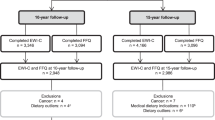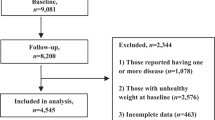Abstract
Background and objective:
To provide an overview of methods used to assess food and nutrient intake, nutritional knowledge and diet-related attitudes in the Healthy Lifestyle in Europe by Nutrition in Adolescence Cross-Sectional Study (HELENA-CSS), with selected results from the feasibility study.
Material and Methods:
To assess food intake in 13- to 16-year-old adolescents, a previously developed computer-assisted and self-administered 24-h recall was adapted for international use. Food consumption data were linked to national food composition databases to calculate energy and nutrient intakes. To assess nutritional knowledge in pupils not having any special (trained) education concerning ‘nutrition’, a 23-item validated multiple choice questionnaire was adapted. To assess eating attitudes, behaviour and/or putative problems with body weight in adolescents, a validated inventory covering 60 questions or statements was adapted for the study. In a feasibility study, instruments, data collection and processing were tested in one school class in each of the 10 participating European cities.
Results and Conclusions:
The feasibility study provided plausible results, quite consistent between countries. Against this background and for the first time, standardized and uniform methodology was made available for the main study to assess and characterize dietary intake, nutritional knowledge and eating attitudes.
This is a preview of subscription content, access via your institution
Access options
Subscribe to this journal
Receive 12 print issues and online access
$259.00 per year
only $21.58 per issue
Buy this article
- Purchase on Springer Link
- Instant access to full article PDF
Prices may be subject to local taxes which are calculated during checkout
Similar content being viewed by others
References
Lambert J, Agostoni C, Elmadfa I, Hulshof K, Krause E, Livingstone B et al. Dietary intake and nutritional status of children and adolescents in Europe. Br J Nutr 2004; 92 (Suppl 2): S147–S211.
Moreno LA, De Henauw S, Gonz?les-Gross M, Kersting M, Moln?r D, Gottrand F et al., on behalf of the HELENA Study Group. Design and implementation of the Healthy Lifestyle in Europe by Nutrition in Adolescence Cross-Sectional Study. Int J Obes (London) 2008; 32 (Suppl 5): S4–S11.
Iliescu C, B?ghin L, Maes L, De Bourdeaudhuij I, Libersa C, Vereecken C et al., on behalf of the HELENA Study Group. Socioeconomic questionnaire and clinical assessment in the HELENA Cross-Sectional Study: methodology. Int J Obes (London) 2008; 32 (Suppl 5): S19–S25.
Biro G, Hulshof KF, Ovesen L, Amorim Cruz JA . Selection of methodology to assess food intake. Eur J Clin Nutr 2002; 56 (Suppl 2): S25–S32.
Vereecken CA, Covents M, Matthys C, Maes L . Young adolescents' nutrition assessment on computer (YANA-C). Eur J Clin Nutr 2005; 59: 658–667.
Dehne LI, Klemm C, Henseler G, Hermann-Kunz E . The German Food Code and Nutrient Data Base (BLS II.2). Eur J Epidemiol 1999; 15: 355–359.
Deutsche Forschungsanstalt für Lebensmittelchemie (eds). Food Composition and Nutrition Tables, 6th edn. Medpharm GmbH Scientific Publishers: Stuttgart, 2000.
Sichert-Hellert W, Kersting M, Chahda C, Schaefer R, Kroke A . German food composition database for dietary evaluations in children and adolescents. J Food Compost Anal 2007; 20: 63–70.
Slimani N, Deharveng G, Unwin I, Vignat J . Standardisation of an European end-user nutrient database for nutritional epidemiology: what can we learn from the EPIC Nutrient Database (ENDB) Project? Trends in Food Science & Technology 2007; 18: 407–419.
Egan MB, Fragodt A, Raats MM, Hodgkins C, Lumbers M . The importance of harmonizing food composition data across Europe. Eur J Clin Nutr 2007; 61: 813–821.
Charrondiere RU, Vignat J, Møller A, Ireland J, Becker W, Church S et al. The European Nutrient Database (ENDB) for Nutritional Epidemiology. J Food Compost Anal 2002; 15: 435–451.
EuroFIR. European Food Information Resource Network. http://www.eurofir.net.
Møller A, Unwin ID, Becker W, Ireland J . EuroFIR's food databank systems for nutrients and bioactives. Trends in Food Science & Technology 2007; 18: 428–433.
Barkoukis H . Importance of understanding food consumption patterns. J Am Diet Assoc 2007; 107: 234–236.
Kant AK . Indexes of overall diet quality: a review. J Am Diet Assoc 1996; 96: 785–791.
Kant AK, Schatzkin A, Harris TB, Ziegler RG, Block G . Dietary diversity and subsequent mortality in the First National Health and Nutrition Examination Survey Epidemiologic Follow-up Study. Am J Clin Nutr 1993; 57: 434–440.
Kant AK . Dietary patterns and health outcomes. J Am Diet Assoc 2004; 104: 615–635.
Kant AK, Graubard BI . A comparison of three dietary pattern indexes for predicting biomarkers of diet and disease. J Am Coll Nutr 2005; 24: 294–303.
Ruel MT . Operationalizing dietary diversity: a review of measurement issues and research priorities. J Nutr 2003; 133: 3911S–3926S.
Colavito EA, Guthrie JF, Hertzler AA, Webb RE . Relationship of diet-health attitudes and nutrition knowledge of household meal planners to the fat and fiber intakes of meal planners and preschoolers. J Nutr Edu 1996; 28: 321–328.
Gracey D, Stanley N, Burke V, Corti B, Beilin LJ . Nutritional knowledge, beliefs and behaviour in teenage school students. Health Edu Res 1996; 11: 187–204.
Harnack L, Block G, Subar A, Lane S, Brand R . Association of cancer prevention-related nutrition knowledge, beliefs, and attitudes to cancer prevention dietary behavior. J Am Diet Assoc 1997; 97: 957–965.
Turrell G . Determinants of Gender differences in Dietary Behavior. Nutrition Research 1997; 17: 1105–1120.
Ben-Simon A, Budescu DV, Nevo B . A Comparative Study of Measures of Partial Knowledge in Multiple-Choice Tests. Applied Psychological Measurement 1997; 21: 65–88.
Diehl JM . Ernährungswissen von Kindern und Jugendlichen. Verbraucherdienst 1999; 44: 282–287.
Diehl JM . Attitudes to eating and body weight in 11- to 16-year-old adolescents. Schweiz Med Wochenschr 1999; 129: 162–175.
Drescher LS, Thiele S, Mensink GB . A new index to measure healthy food diversity better reflects a healthy diet than traditional measures. J Nutr 2007; 137: 647–651.
Baranowski T, Domel SB . A cognitive model of children's reporting of food intake. Am J Clin Nutr 1994; 59: 212S–217S.
Livingstone MB, Robson PJ . Measurement of dietary intake in children. Proc Nutr Soc 2000; 59: 279–293.
Anonymous. NCS Dietary Assessment Literature Review. National Cancer Institute 2004, http://riskfactor.cancer.gov/tools/children/review/.
Livingstone MB, Robson PJ, Wallace JM . Issues in dietary intake assessment of children and adolescents. Br J Nutr 2004; 92 (Suppl 2): S213–S222.
Vereecken CA, Covents M, Sichert-Hellert W, Alvira JMF, Le Donne C et al., on behalf of the HELENA Study Group. Development and evaluation of self-administration of a computerized 24-h dietary recall method for adolescents in Europe. Int J Obes (London) 2008; 32 (Suppl 5): S26–S34.
Aranceta J, Perez-Rodrigo C, Ribas L, Serra-Majem L . Sociodemographic and lifestyle determinants of food patterns in Spanish children and adolescents: the enKid study. Eur J Clin Nutr 2003; 57 (Suppl 1): S40–S44.
Perez-Rodrigo C, Ribas L, Serra-Majem L, Aranceta J . Food preferences of Spanish children and young people: the enKid study. Eur J Clin Nutr 2003; 57 (Suppl 1): S45–S48.
Kersting M, Alexy U, Kroke A, Lentze MJ . Nutrition of children and adolescents. Results of the DONALD Study. Bundesgesundheitsblatt Gesundheitsforschung Gesundheitsschutz 2004; 47: 213–218.
Wardle J, Parmenter K, Waller J . Nutrition knowledge and food intake. Appetite 2000; 34: 269–275.
Dallongeville J, Marecaux N, Cottel D, Bingham A, Amouyel P . Association between nutrition knowledge and nutritional intake in middle-aged men from Northern France. Public Health Nutr 2001; 4: 27–33.
Godina-Zarfel B, Elmadfa I . Food preferences, nutritional knowledge and their impact on nutrient intake in Austrian children and adolescents. Nutrition 1993; 17: 314–315.
Pirouznia M . The association between nutrition knowledge and eating behaviour in male and female adolescents in the US. Int J Food Sci Nutr 2001; 52: 127–132.
Reinehr T, Kersting M, Chahda C, Andler W . Nutritional knowledge of obese compared to non obese children. Nutr Res 2003; 23: 645–649.
Downs D, Dinallo JM, Savage JS, Davison KK . Determinants of eating attitudes among overweight and nonoverweight adolescents. J Adolesc Health 2007; 41: 138–145.
Nowak M . The weight-conscious adolescent: body image, food intake, and weight-related behavior. J Adolesc Health 1998; 23: 389–398.
Crow S, Eisenberg ME, Story M, Neumark-Sztainer D . Psychosocial and behavioral correlates of dieting among overweight and non-overweight adolescents. J Adolesc Health 2006; 38: 569–574.
Neumark-Sztainer D, Paxton SJ, Hannan PJ, Haines J, Story M . Does body satisfaction matter? Five-year longitudinal associations between body satisfaction and health behaviors in adolescent females and males. J Adolesc Health 2006; 39: 244–251.
Koletzko B, de la Gueronniere V, Toschke AM, von Kries R . Nutrition in children and adolescents in Europe: what is the scientific basis? Introduction. Br J Nutr 2004; 92 (Suppl 2): S67–S73.
Acknowledgements
We are very grateful to Ellen Koeppen for proofreading. The HELENA Study was carried out with the financial support of the European Community Sixth RTD Framework Programme (Contract FOOD-CT-2005-007034). The content of this paper reflects only the authors' views, and the European Community is not liable for any use that may be made of the information contained therein. The researchers from the University of Zaragoza, Spain (MIM) are complementarily supported by FUNDACIÓN MAPFRE (Spain).
Author information
Authors and Affiliations
Consortia
Corresponding author
Additional information
Conflict of interest
The authors state no conflict of interest.
Rights and permissions
About this article
Cite this article
Kersting, M., Sichert-Hellert, W., Vereecken, C. et al. Food and nutrient intake, nutritional knowledge and diet-related attitudes in European adolescents. Int J Obes 32 (Suppl 5), S35–S41 (2008). https://doi.org/10.1038/ijo.2008.181
Published:
Issue Date:
DOI: https://doi.org/10.1038/ijo.2008.181
Keywords
This article is cited by
-
Patterns and correlates of nutrition knowledge across five countries in the 2018 international food policy study
Nutrition Journal (2023)
-
Adolescents’ perception of dietary behaviour in a public school in Chile: a focus groups study
BMC Public Health (2020)
-
Foods contributing to vitamin B6, folate, and vitamin B12 intakes and biomarkers status in European adolescents: The HELENA study
European Journal of Nutrition (2017)
-
Dietary behaviour and parental socioeconomic position among adolescents: the German Health Interview and Examination Survey for Children and Adolescents 2003–2006 (KiGGS)
BMC Public Health (2015)
-
Institutionalisierte Wissenschaft und Praxis der Ernährung gesunder Kinder
Monatsschrift Kinderheilkunde (2014)



